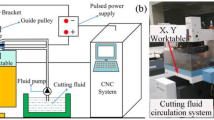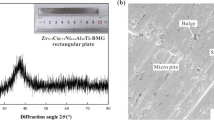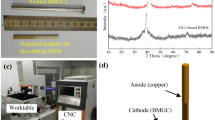Abstract
So far, many investigations have reported that Zr-based bulk metallic glasses (BMGs) could be precisely and flexibly shaped by electrical discharge machining (EDM). However, EDM induced crystallization and roughness is still a bottleneck. In this research, bench-mode electrochemical surface smoothing (ESS) in the NaCl-ethylene glycol (EG) electrolyte has been proposed to post-process the spark erosion treated Zr-based BMGs in order to solve the abovementioned problems. The utilization of the NaCl-EG electrolyte overcomes the difference in electrochemical dissolution mechanisms of multiple components contained in Zr-based BMGs. Taking a sort of Zr-based BMGs, Vit1 (Zr41.2Ti13.8Cu12.5Ni10.0Be22.5), as an example, voltammetry and chronoamperometry methods have been performed on the BMG surface before and after wire-EDM, respectively, in the NaCl-EG electrolyte to reveal the steady and transient electrochemical behaviors. In order to achieve high-efficiency and high-quality ESS of Zr-based BMGs, a 3D printed setup with lateral flushing has been developed, combined with the micron sized inter-electrode gap (IEG) and the pulse current. The surface morphologies after ESS have been compared to evaluate the effects of the initial surface morphologies, dwell time, and pulse parameters. The surface material properties and mechanical performance before and after ESS have also been investigated by EDS, XRD, XPS, and nanoindentation. The results suggests that the proposed ESS method is capable of quickly eliminating the crystalline layer induced by the thermal shock and reducing roughness caused by the discharge craters, which has been finally validated by fast ESS of two Zr-based BMG molds with ruled surfaces in the NaCl-EG solution.






















Similar content being viewed by others
References
Hua N, Liao Z, Chen W, Huang Y, Zhang T (2017) Effects of noble elements on the glass-forming ability, mechanical property, electrochemical behavior and tribocorrosion resistance of Ni- and Cu-free Zr-Al-Co bulk metallic glass. J Alloys Compd 725:403–414
Hu Q, Fu MW, Zeng XR (2014) Evaluation of thermoplastic formability of Zr-based bulk metallic glasses and its correlation with characteristic temperature parameters. J Alloys Compd 602:326–330
Shi H, Zhao W, Wei X, Ding Y, Shen X, Liu W (2020) Effect of Ti addition on mechanical properties and corrosion resistance of Ni-free Zr-based bulk metallic glasses for potential biomedical applications. J Alloys Compd 815:152636
Meng L, Zeng Y, Fang X, Zhu D (2018) Micro-shaping of metallic glass by wire electrochemical micro-machining with a reciprocating traveling workpiece. J Alloys Compd 739:235–248
Meng L, Zeng Y, Fang X, Zhu D (2017) Wire electrochemical micromachining of metallic glass using a carbon nanotube fiber electrode. J Alloys Compd 709:760–771
Zhang L, Huang H (2019) Micro machining of bulk metallic glasses: a review. Int J Adv Manuf Technol 100(1):637–661
Wang T, Wu X, Zhang G, Chen Y, Xu B, Ruan S (2020) Study on surface roughness and top burr of micro-milled Zr-based bulk metallic glass in shear dominant zone. Int J Adv Manuf Technol 107(9):4287–4299
Ray D, Puri AB, Hanumaiah N, Halder S (2020) Analysis on specific cutting energy in micro milling of bulk metallic glass. Int J Adv Manuf Technol 108(1):245–261
Liu Y, Gong Y, Liu W, Xu L, Sun X (2020) Experimental investigations on flank contour accuracy of milling groove for Zr-based bulk metallic glass using mesoscale milling. Int J Adv Manuf Technol 108(3):785–799
Liu Y, Gong Y, Liu W, Sun X, Xu L (2020) Effect of milling parameters on chip shape and chip morphology for Zr-based bulk metallic glass by using micro-groove milling. Int J Adv Manuf Technol 111(5):1587–1602
Ya-Dong G, Yin L, Yao S, Xue-Long W, Qiang L, Shuo-Shuo Q, Ming C (2018) Experimental and emulational investigations into grinding characteristics of Zr-based bulk metallic glass (BMG) using microgrinding. Int J Adv Manuf Technol 97(9):3431–3451
Yin L, Ya-dong G, Yao S, Huan Z, Qiang L (2018) Microgrinding characteristics of Zr-based bulk metallic glasses. Int J Adv Manuf Technol 94(5):2401–2417
Chau SY, To S, Sun Z, Wu H (2020) Twinned-serrated chip formation with minor shear bands in ultra-precision micro-cutting of bulk metallic glass. Int J Adv Manuf Technol 107(11):4437–4448
Huang Z, Liang X, Chang C, Ma J (2019) WEDM-LS processing sophisticated and durable Zr-based metallic glass mold insert for micro structure injection of polymers. Biomed Microdevices 21(1):13
Chen XH, Zhang XC, Zhang Y, Chen GL (2008) Fabrication and characterization of metallic glasses with a specific microstructure for micro-electro-mechanical system applications. J Non-Cryst Solids 354(28):3308–3316
Huang H, Yan J (2015) On the surface characteristics of a Zr-based bulk metallic glass processed by microelectrical discharge machining. Appl Surf Sci 355:1306–1315
Huang H, Yan J (2016) Microstructural changes of Zr-based metallic glass during micro-electrical discharge machining and grinding by a sintered diamond tool. J Alloys Compd 688:14–21
Maharana HS, Murty SVSN, Ramkumar J, Mondal K (2020) Continuous and ordered surface microtexturing on Cu and Ni-based alloys by novel electrochemical dissolution. J Alloys Compd 817:153263
Jacquet PA, Figour H (1930) Inventors French patent. France patent 707526
Wu X, Li S, Jia Z, Xin B, Yin X (2019) Using WECM to remove the recast layer and reduce the surface roughness of WEDM surface. J Mater Process Technol 268:140–148
Zeng Z, Wang Y, Wang Z, Shan D, He X (2012) A study of micro-EDM and micro-ECM combined milling for 3D metallic micro-structures. Precis Eng 36(3):500–509
Kurita T, Chikamori K, Kubota S, Hattori M (2006) A study of three-dimensional shape machining with an ECμM system. Int J Mach Tools Manuf 46(12):1311–1318
Skoczypiec S, Ruszaj A (2014) A sequential electrochemical–electrodischarge process for micropart manufacturing. Precis Eng 38(3):680–690
Koza JA, Sueptitz R, Uhlemann M, Schultz L, Gebert A (2011) Electrochemical micromachining of a Zr-based bulk metallic glass using a micro-tool electrode technique. Intermetallics 19(4):437–444
Gebert A, Gostin PF, Sueptitz R, Oswald S, Abdi S, Uhlemann M, Eckert J (2014) Polarization studies of Zr-based bulk metallic glasses for electrochemical machining. J Electrochem Soc 161(4):E66–E73
Cole KM, Kirk DW, Singh CV, Thorpe SJ (2017) Optimizing electrochemical micromachining parameters for Zr-based bulk metallic glass. J Manuf Process 25:227–234
Fushimi K, Kondo H, Konno H (2009) Anodic dissolution of titanium in chloride-containing ethylene glycol solution. Electrochim Acta 55(1):258–264
Kim D, Son K, Sung D, Kim Y, Chung W (2015) Effect of added ethanol in ethylene glycol–NaCl electrolyte on titanium electropolishing. Corros Sci 98:494–499
Liu W, Luo Z, Kunieda M (2020) Electrolyte jet machining of Ti1023 titanium alloy using NaCl ethylene glycol-based electrolyte. J Mater Process Technol 283:116731
Lohrengel MM, Rataj KP, Münninghoff T (2016) Electrochemical machining—mechanisms of anodic dissolution. Electrochim Acta 201(Supplement C):348–353
Padhy N, Ningshen S, Kamachi Mudali U (2010) Electrochemical and surface investigation of zirconium based metallic glass Zr59Ti3Cu20Al10Ni8 alloy in nitric acid and sodium chloride media. J Alloys Compd 503(1):50–56
Wang B, Xu KK, Shi XH, Zhang M, Qiao JW, Gao CH, Wu YC (2019) Electrochemical and chemical corrosion behaviors of the in-situ Zr-based metallic glass matrix composites in chloride-containing solutions. J Alloys Compd 770:679–685
Liu G, Tong H, Li Y, Zhong H (2020) Investigation on passivation and transient electrochemical behavior of Fe–Cr–Ni based alloy in micro ECM. J Electrochem Soc 167(6):063503
Qiu Z, Li Z, Fu H, Zhang H, Zhu Z, Wang A, Li H, Zhang L, Zhang H (2020) Corrosion mechanisms of Zr-based bulk metallic glass in NaF and NaCl solutions. J Mater Sci Technol 46:33–43
Kawashima A, Ohmura K, Yokoyama Y, Inoue A (2011) The corrosion behaviour of Zr-based bulk metallic glasses in 0.5M NaCl solution. Corros Sci 53(9):2778–2784
Green BA, Meyer HM, Benson RS, Yokoyama Y, Liaw PK, Liu CT (2008) A study of the corrosion behaviour of Zr50Cu(40−X)Al10PdX bulk metallic glasses with scanning Auger microanalysis. Corros Sci 50(7):1825–1832
Zhang B, Lee X, Bai J, Guo J, Wang P, C-n S et al (2017) Study of selective laser melting (SLM) Inconel 718 part surface improvement by electrochemical polishing. Mater Des 116:531–537
Acknowledgements
This project is supported by the National Natural Science Foundation of China (Grant Nos. 52005342 and 51971150). The authors also would like to thank Dr. Junjie Yang at Jinan University for the fruitful discussions on electrochemical analysis. The authors appreciate the assistance from the postgraduates at College of Mechatronics and Control Engineering, Shenzhen University, during the preparation for the experiments.
Availability of data and material
The authors confirm that material supporting the findings of this work is available within the article. The collected data of this work are not available within the article.
Funding
This project is supported by the National Natural Science Foundation of China (Grant Nos. 52005342 and 51971150).
Author information
Authors and Affiliations
Corresponding authors
Ethics declarations
Ethics approval
Not applicable.
Consent to participate
Not applicable.
Consent for publication
Not applicable
Competing interests
The authors declare no competing interests.
Additional information
Publisher’s note
Springer Nature remains neutral with regard to jurisdictional claims in published maps and institutional affiliations.
Rights and permissions
About this article
Cite this article
Guo, C., Wu, B., Xu, B. et al. Electrochemical surface smoothing of spark erosion treated Zr-based bulk metallic glasses in NaCl-ethylene glycol electrolyte. Int J Adv Manuf Technol 116, 1591–1607 (2021). https://doi.org/10.1007/s00170-021-07561-x
Received:
Accepted:
Published:
Issue Date:
DOI: https://doi.org/10.1007/s00170-021-07561-x




